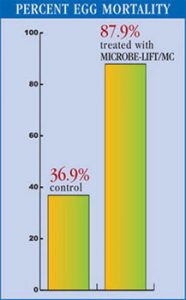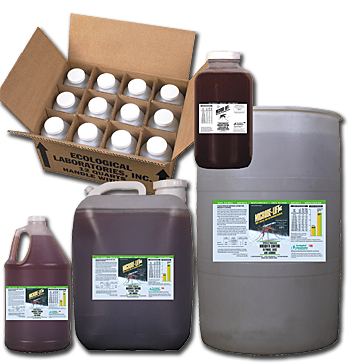MICROBE-LIFT/MC, an environmentally safe and effective approach to mosquito control (for Export of U.S. Only)
While concern over mosquito borne diseases hasn’t been an issue developing nations in recent years until the incidence of the West Nile virus in New York in 2000, certain mosquito borne diseases like malaria continue to be one of the leading causes of death in many undeveloped countries.
Trying to minimize the risk of mosquito borne diseases is a challenging task. For years, the widespread use of DDT provided a comfortable level of control. However, due to the adverse environmental effects resulting from the persistence of DDT in the environment the pesticide was banned in most countries although it is still used where the public health hazard of mosquito borne diseases far outweighs concerns over environmental damage. There are now some widely used bioinsecticides, e.g.: B. thuringiensis. While fairly effective and harmless to man and animals, biopesticides can be expensive to apply over large areas.
Mosquitos are usually found in large numbers where it is warm and there are areas of stagnant water where they can lay their eggs to hatch. When geographical regions go through a wet season followed by a warm season there is bound to be some degree of a mosquito problem. Like many other insects, mosquitos lay thousands of eggs due to the low percentage of eggs that hatch and become mature adults. At every stage of development a portion of the immature mosquitos are lost due to predation, pesticides or other factors. Under normal conditions only a fraction of the eggs yield mature adults.
Over the years, many users of MICROBE-LIFT/MC products have observed that there seemed to be a reduction in the insect populations around lagoons, etc. when they used the product. In order to determine if this was merely a coincidence or real we contracted Insect Control and Research Inc., of Baltimore, MD to perform studies on what impact, if any, MICROBE-LIFT/MC had on the hatching of mosquito eggs and the adult emergence of the hatched larval instars.
The results showed that egg mortality increased from 36.9% in the control replicates to 87.9% in the replicates seeded with MICROBE-LIFT/MC, an increase of 238%. By lowering the hatch rate to this level along with the other normal adversities faced by the maturing larvae application of MICROBE-LIFT/MC can be cost-effective, environmentally sound form of mosquito control.

Executive Summary
Ecological Laboratories, Inc.
Mosquito Larvicidal Evaluation
ICR Project No. 287-0031
In-life Completion date: 1/16/01
A bacterial product was evaluated for its potential as a killing agent against the aquatic stages of laboratory-reared Aedes aegypti. The efficacy of the bacterial product was assessed for its effect upon the egg stage, the larval stages, the pupla stage and the resulting emergence of adults.
The bacterial product was effective on the egg stage, increasing egg mortality from 36.9 +/-18% in the untreated controls to 87.9+/- 2.6% in the treatments. The product did not prevent pupation, and therefore did not adversely affect the later instar larvae. There may have been some efficacy against early instar larvae, i.e. first instar, as evidenced by low counts of adults compared to counts of hatched eggs. Under the conditions of this study, tracking first instar larvae was not possible. The emergence of adults from controls was 73.0+/-10.1% while that of the treatments was 35.6+/-23.5%.
* Column numbers refer to instar; **based on replicates 2,3,4 and 5
In conclusion, the bacterial product was effective in increasing egg mortality under the conditions of this study. The product had no detectable effect on the larvae or the pupae.
Robin G. Todd, PhD, BCE – Director
Study Title: Evaluation of a Bacterial Product for Mosquito Control
Project Number 287-0031
Protocol Number N2870500001B195
Testing Facility
Insect Control & Research, Inc.
1330 Dillon Heights Avenue
Baltimore, MD 21228-1199


